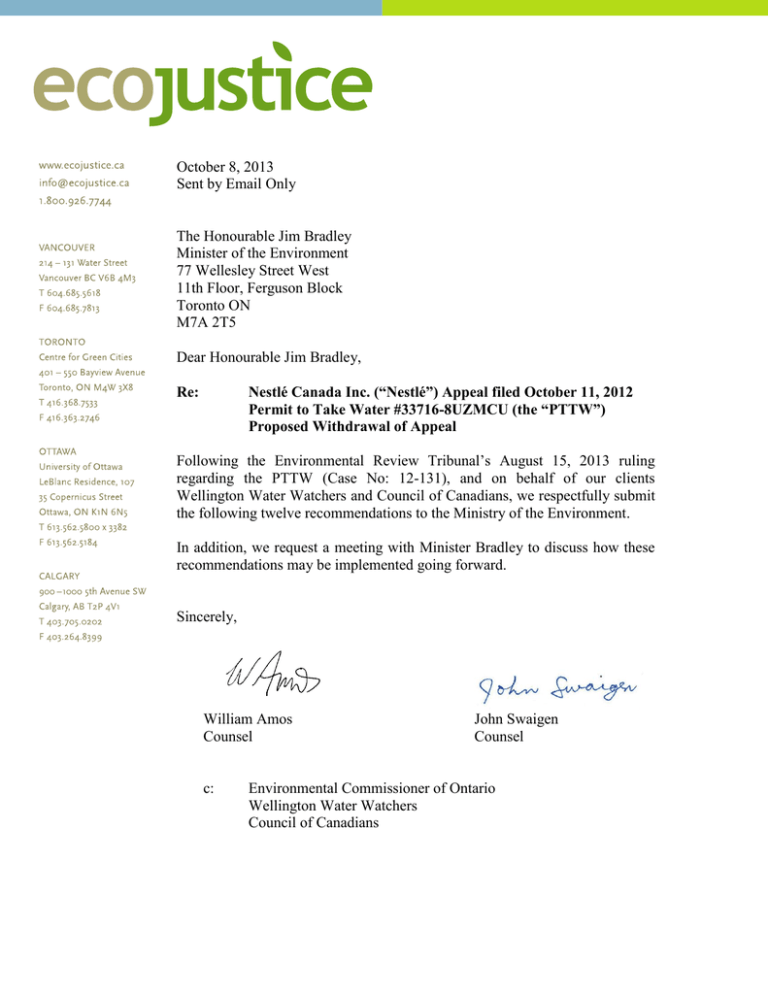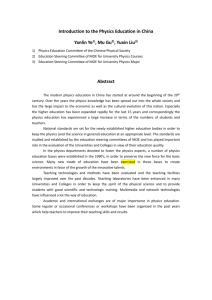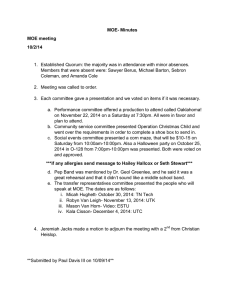October 8, 2013 Sent by Email Only The Honourable Jim Bradley
advertisement

October 8, 2013 Sent by Email Only The Honourable Jim Bradley Minister of the Environment 77 Wellesley Street West 11th Floor, Ferguson Block Toronto ON M7A 2T5 Dear Honourable Jim Bradley, Nestlé Canada Inc. (“Nestlé”) Appeal filed October 11, 2012 Permit to Take Water #33716-8UZMCU (the “PTTW”) Proposed Withdrawal of Appeal Re: Following the Environmental Review Tribunal’s August 15, 2013 ruling regarding the PTTW (Case No: 12-131), and on behalf of our clients Wellington Water Watchers and Council of Canadians, we respectfully submit the following twelve recommendations to the Ministry of the Environment. In addition, we request a meeting with Minister Bradley to discuss how these recommendations may be implemented going forward. Sincerely, William Amos Counsel c: John Swaigen Counsel Environmental Commissioner of Ontario Wellington Water Watchers Council of Canadians Detailed list of policy reforms needed to protect groundwater Responding to Low Water/Drought Conditions 1. Drought Declaration: The Ministry of Environment (MoE) works with the Ministry of Natural Resources (MNR) to remove prohibitive barriers from obtaining a declaration of Level III Condition under the Ontario Low Water Response Plan. The Ministries establish a mechanism to officially declare a Level III Condition that effectively prohibits non-essential water taking permits from operating in times of drought. 2. Low Water Planning: MoE works with MNR to change the Ontario Low Water Response Plan to make responses to Level I and II Conditions mandatory for certain types of use. This includes consistency and coordination between municipalities in water restrictions so that they are not required to reduce their water use while industry does not. As well, MoE works with MNR to identify groundwater indicators to identify low water/drought conditions. Preventing Low Water/Drought Conditions and Ensuring Principled Water Management 3. Prioritization of uses:1 MoE develops a policy on the hierarchy of water takings in low water conditions that maintains ecosystem protection as the primary consideration.2 MoE “develop[s] a clear policy for prioritizing water uses under non-drought conditions to ensure that PTTWs are allocated in both an ecologically sustainable and socially desirable manner”.3 4. Pump Test Assessments: MoE establishes baseline assessments and monitors impact of water takings. MoE (not industry) establishes pump test assessments (PTA). For instance, the PTA 1 Supports Principle 1 of the Ministry of the Environment’s Permit to Take Water Manual, April 2005, “The Minister will use an ecosystem approach that considers both water takers’ reasonable needs for water and the natural function of the ecosystem”. See also the Principles for Prioritizing Water Uses in the Environmental Commissioner of Ontario’s Annual Report, 2011/2012 part 2, Losing touch. 2 Environmental Commissioner of Ontario’s Annual Report, 2004-2005, http://www.ecoissues.ca/index.php/Water_Taking_and_Transfer_Regulation_under_the_ OWRA. 3 Environmental Commissioner of Ontario’s Annual Report, 2005-2006, http://www.ecoissues.ca/index.php/Drought_in_Ontario%3F_Groundwater_and_Surface _Water_Impacts_and_Response. report includes water depth measurements relative to the bottom of the corresponding surface water feature at all surface water monitoring stations. The baseline information allows MoE to prevent water takings from causing unacceptable interference with other uses of water, and to effectively resolve such problems if they occur.4 5. High Use Watersheds: MoE works with the MNR to assess the accuracy of using Average Annual Flow and Summer Low Flow maps fixed at a point in time (2004). Further, MoE provides a review mechanism to update these maps that guide management decisions for water use to include “high use watersheds”5 that accurately reflect existing conditions and increasing demands. This would increase MoE’s authority in water management. Further, it would improve the Minister’s capacity to employ adaptive management to better respond to evolving environmental conditions.6 6. Cumulative Impact Assessments: MoE acquires funding to meet the PTTW program requirement for cumulative impact assessment of water takings. The Minister assesses and evaluates the cumulative impact of water takings. 7 7. Water Taking Charges: MoE implements the additional proposed phases of the water taking charges (consulted on publically many years ago) and establishes the envisioned system of fees (by volume) for water takings to help cover the costs of administering an effective PTTW Program, in accordance with established principles and the Ontario Water Resources Act (OWRA). The fee system under the PTTW Program incorporates the value of water for basic human purposes and the public interest. Water taking charges “recover a portion of the costs the Government of Ontario incurs in the administration of the Act … for the purpose of promoting conservation, protection and management of Ontario’s waters and their efficient sustainable use”. 8. Clarification of Principles: MoE revises its Statement of Environmental Values (SEV) to reflect the precautionary principle 4 Principle 2, Permit to Take Water Manual, April 2005, Ministry of the Environment. Section 5, O Reg 387/04. 6 Principle 3, Permit to Take Water Manual, April 2005, Ministry of the Environment. 7 Principle 4, Permit to Take Water Manual, April 2005, Ministry of the Environment. 5 from the Ontario Water Resources Act, and intergenerational equity, which is a core principle of sustainable water use. MoE also applies the precautionary principle in following PTTW Principle 5 that “The Minister … incorporate[s] risk management principles into the permit application/review process.”8 9. Public and Local Agency Involvement: MoE consults with the public and local agencies before discussing and deciding permitting conditions with the Proponent.9 MoE incorporates public input into final decision. 10. Water Permitting Review: MoE reviews all other water-taking permits in a watershed that do not have similar drought restriction conditions and gradually adds them to their permits to take water. Instead of removing the conditions from one entity’s PTTW (e.g. from Nestlé Canada Inc.) to remedy the user being ‘singled out’, MoE keeps those conditions and imposes them on the other permits. 11. Strategic PTTW: MoE assesses and reports on current and future water demands based on expected population, hydrogeology, inflows/outflows, stress on the water source, history of drought in region, and climate change predictions for the watershed. MoE funds this through the full implementation of the water taking charges program. MoE uses these assessments as a strategic basis on which to grant permits to take water. 12. Keeping Water in Watershed: MoE establishes tighter regulation around diversions, including water transfers across boundaries in the OWRA to keep water in its watershed. For example, establish an intra-basin transfer regulation (as enabled by provisions of the OWRA that are not yet in force) and eliminate the 20L loophole, OWRA s. 34.3(3).10 8 Principle 5, Permit to Take Water Manual, April 2005, Ministry of the Environment. Principe 6, Permit to Take Water Manual, April 2005, Ministry of the Environment. 10 34.3(1) “Water transfers: Great Lakes-St. Lawrence River … Basin … Prohibition (2) A person shall not take water from a water basin described in subsection (1) if the person will cause or permit the water to be transferred out of the basin. Exceptions (3) Subsection (2) does not apply if the transfer of water out of the water basin is one of the following: 1. A transfer of water that is in a container having a volume of 20 litres or less.” 9


